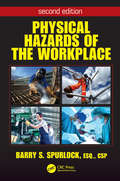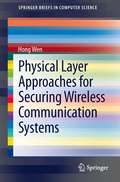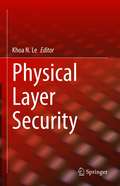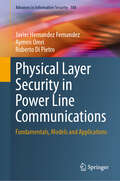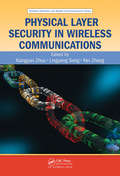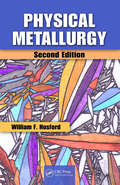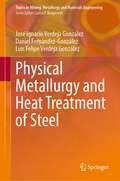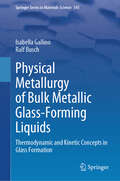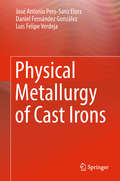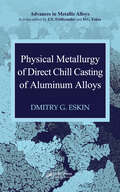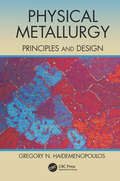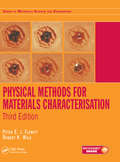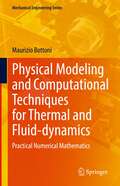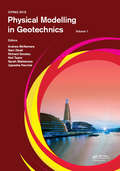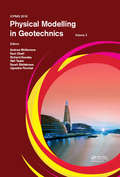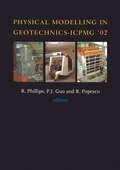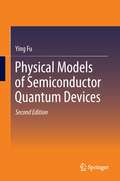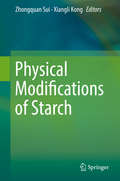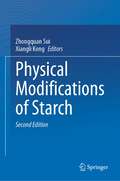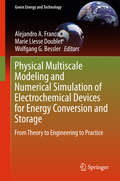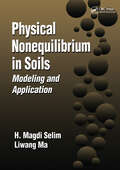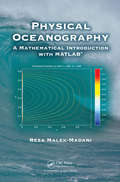- Table View
- List View
Physical Hazards of the Workplace (Occupational Safety & Health Guide Series)
by Barry SpurlockThe recognition and control of hazards in the work environment are the cornerstone of every company’s safety and health plan. Every workplace contains dangers, especially those devoted to technology, machinery, and potentially hazardous material. This book provides you with the information you need to understand the regulations that provide for facility safety and their successful implementation for profitable management of any business. <P><P>FEATURES <li>Explores both occupational and environmental hazards <li>Describes the workplace threats from machines, confined spaces, chemicals, personnel, cumulative trauma, environmental issues, electricity, noise, fire and explosion, and the risk of falling <li>Provides measures to protect the eyes, the head, the respiratory system, the circulatory system, and more <li>Details common fire protection countermeasures from an experienced firefighter and fire instructor <li>Addresses ladders, scaffolding and OSHA fall protection standards <li>Includes sections on PPE, laser safety, and forklifts
Physical Layer Approaches for Securing Wireless Communication Systems
by Hong WenThis book surveys the outstanding work of physical-layer (PHY) security, including the recent achievements of confidentiality and authentication for wireless communication systems by channel identification. A practical approach to building unconditional confidentiality for Wireless Communication security by feedback and error correcting code is introduced and a framework of PHY security based on space time block code (STBC) MIMO system is demonstrated. Also discussed is a scheme which combines cryptographic techniques implemented in the higher layer with the physical layer security approach using redundant antennas of MIMO systems to provide stronger security for wireless networks. The channel responses between communication peers have been explored as a form of fingerprint with spatial and temporal uniqueness. Finally, the book develops a new lightweight method of channel identification for Sybil attack and node clone detection in wireless sensor networks (WSNs).
Physical Layer Multi-Core Prototyping
by Slaheddine Aridhi Jean-François Nezan Maxime Pelcat Jonathan PiatBase stations developed according to the 3GPP Long Term Evolution (LTE) standard require unprecedented processing power. 3GPP LTE enables data rates beyond hundreds of Mbits/s by using advanced technologies, necessitating a highly complex LTE physical layer. The operating power of base stations is a significant cost for operators, and is currently optimized using state-of-the-art hardware solutions, such as heterogeneous distributed systems. The traditional system design method of porting algorithms to heterogeneous distributed systems based on test-and-refine methods is a manual, thus time-expensive, task. Physical Layer Multi-Core Prototyping: A Dataflow-Based Approach provides a clear introduction to the 3GPP LTE physical layer and to dataflow-based prototyping and programming. The difficulties in the process of 3GPP LTE physical layer porting are outlined, with particular focus on automatic partitioning and scheduling, load balancing and computation latency reduction, specifically in systems based on heterogeneous multi-core Digital Signal Processors. Multi-core prototyping methods based on algorithm dataflow modeling and architecture system-level modeling are assessed with the goal of automating and optimizing algorithm porting. With its analysis of physical layer processing and proposals of parallel programming methods, which include automatic partitioning and scheduling, Physical Layer Multi-Core Prototyping: A Dataflow-Based Approach is a key resource for researchers and students. This study of LTE algorithms which require dynamic or static assignment and dynamic or static scheduling, allows readers to reassess and expand their knowledge of this vital component of LTE base station design.
Physical Layer Security
by Khoa N. LeThis book studies the vulnerability of wireless communications under line-of-sight (LoS) and non-LoS correlated fading environments. The authors theoretically and practically provide physical layer security analyses for several technologies and networks such as Fifth-Generation (5G) networks, Internet of Things (IoT) applications, and Non-orthogonal multiple access (NOMA). The authors have provided these under various practical scenarios, and developed theoretical aspects to validate their proposed applications. Presents physical layer security (PLS) under correlated fading environments, 5G wireless networks, and NOMA networks;Provides end-to-end analyses, combination of channel correlation and outdated CSI and their effects on PL;Includes contributions of PLS research written by global experts in academia and industry.
Physical Layer Security in Power Line Communications: Fundamentals, Models and Applications (Advances in Information Security #108)
by Roberto Di Pietro Javier Hernandez Fernandez Aymen OmriThis book emerges as a seminal work, addressing the critical need for robust security for power line communications (PLC), during an era where digital interconnectivity is paramount yet vulnerable. This comprehensive volume offers a deep dive into the realm of PLC, a technology increasingly central to our interconnected power grid infrastructure and explores its potential as a cornerstone for various applications. This book opens with a clear and informative introduction to PLC, shedding light on its present status and importance. The authors then delve into the heart of the matter: the application of physical layer security (PLS) in PLC networks. PLS, an emerging field in its own right, is presented as a vital complement or alternative to traditional communications security methods, especially relevant for securing networks of low-complexity devices that are pivotal in PLC applications. This exhaustive treatment of PLS in PLC is unprecedented, both in its scope and depth. This book not only clarifies the fundamental principles of PLS in PLC, but also provides actionable insights for mitigating risks and enhancing resilience. Targeted towards engineers, researchers, graduate students and practitioners grappling with the multifaceted aspects of cybersecurity in energy infrastructure, this book stands out for its clarity, rigor, and the practical applicability of its content. The authors share the results of their extensive research journey and practice, presenting compelling use cases that underscore the practicality of their findings, as well as insights to be prepared for the next challenges in the security of the grid infrastructure.
Physical Layer Security in Wireless Communications (Wireless Networks and Mobile Communications #20)
by Lingyang Song Yan Zhang Xiangyun ZhouPhysical layer security has recently become an emerging technique to complement and significantly improve the communication security of wireless networks. Compared to cryptographic approaches, physical layer security is a fundamentally different paradigm where secrecy is achieved by exploiting the physical layer properties of the communication syst
Physical Metallurgy
by Peter HaasenThis is the fourth edition of a work which first appeared in 1965. The first edition had approximately one thousand pages in a single volume. This latest volume has almost three thousand pages in 3 volumes which is a fair measure of the pace at which the discipline of physical metallurgy has grown in the intervening 30 years. Almost all the topics previously treated are still in evidence in this version which is approximately 50% bigger than the previous edition. All the chapters have been either totally rewritten by new authors or thoroughly revised and expanded, either by the third-edition authors alone or jointly with new co-authors. Three chapters on new topics have been added, dealing with dry corrosion, oxidation and protection of metal surfaces; the dislocation theory of the mechanical behavior of intermetallic compounds; and (most novel) a chapter on polymer science for metallurgists, which analyses the conceptual mismatch between metallurgists' and polymer scientists' way of looking at materials. Special care has been taken throughout all chapters to incorporate the latest experimental research results and theoretical insights. Several thousand citations to the research and review literature are included in this edition. There is a very detailed subject index, as well as a comprehensive author index. The original version of this book has long been regarded as the standard text in physical metallurgy and this thoroughly rewritten and updated version will retain this status.
Physical Metallurgy
by William F. HosfordFor students ready to advance in their study of metals, Physical Metallurgy, Second Edition uses engaging historical and contemporary examples that relate to the applications of concepts in each chapter.This book combines theoretical concepts, real alloy systems, processing procedures, and examples of real-world applications. The author uses his ex
Physical Metallurgy and Heat Treatment of Steel (Topics in Mining, Metallurgy and Materials Engineering)
by José Ignacio Verdeja González Luis Felipe Verdeja González Daniel Fernández-GonzálezThis book covers the physical metallurgy of steels as well as the heat treatments used to improve the their properties. A full chapter is dedicated to the atmospheres in the steelmaking, including the implications of the own gases generated in the iron and steelmaking factories and how they could be applied in these treatments. This book is specially conceived for graduate and undergraduate courses, being the result of more than 30 years of teaching experience in courses for undergraduate, graduate (master and Ph. D.), and companies (technicians). The trends in the re-utilization of industrial gases in the iron and steelmaking process are discussed by the authors. Additionally, the book comprises 41 solved exercises, problems and case-studies, as a complement of the theoretical sections of the text. These exercises, problems, and case-studies are based on problems observed in the industrial practice.
Physical Metallurgy of Bulk Metallic Glass-Forming Liquids: Thermodynamic and Kinetic Concepts in Glass Formation (Springer Series in Materials Science #341)
by Isabella Gallino Ralf BuschThis book deepens the current understanding of the thermodynamics and kinetics of metallic glass-forming liquids, and their connection with the glass-formation process in terms of fundamental physical metallurgy concepts. It surveys and reports on the progress made in the last few decades to access the ultra-viscous liquid state of thermally stable bulk metallic glass (BMG) forming alloys and study the changes in atomic structure, viscosity, and enthalpy during the vitrification including physical aging.Featuring a comprehensive look at the physical properties of the undercooled liquid in the ultra-viscous state at temperatures near the glass transition, the book reports on detailed investigations of the thermodynamic functions, viscosity, volume, relaxation time, and structural ordering in the undercooled liquid. Additionally, it introduces state-of-the-art in-situ characterization tools such as chip-calorimetry, synchrotron x-ray diffraction, and x-ray photon correlation spectroscopy as applied to novel studies of liquid–liquid transitions in the supercooled liquid and in the vicinity of the glass transition, and establishes these common, if not universal, phenomena in BMG-forming alloys.This book is intended for researchers, graduate students, and professionals in the fields of materials science, physical metallurgy, and condensed matter physics, who are interested in the thermodynamics and kinetics of metallic glass-forming liquids and their connection with the glass formation process.
Physical Metallurgy of Cast Irons
by José Antonio Pero-Sanz Elorz Daniel Fernández González Luis Felipe VerdejaThis textbook focuses on cast irons, the second material in production and consumption after steel. The authors describe the Fe-C stable and metastable diagrams from the physical-chemical metallurgy point of view. The main properties of cast irons are presented and justified for all kinds of cast irons: low cost, excellent castability, mechanical properties depending on the graphite morphology (gray irons) and high wear resistance (white irons). The physical metallurgy of highly alloyed cast irons is also described, particularly that one of those used as a consequence of their abrasion, corrosion and heat resistance. The book presents exercises, problems and cases studies, with different sections dedicated to the molding practice. The book finishes with the production cast irons in the cupola furnace. This concise textbook is particularly of interest for students and engineers that work in industries related to cast irons.
Physical Metallurgy of Direct Chill Casting of Aluminum Alloys (Advances in Metallic Alloys)
by Dmitry G. EskinPulling together information previously scattered throughout numerous research articles into one detailed resource, this book connects the fundamentals of structure formation during solidification with the practically observed structure and defect patterns in billets and ingots. The author examines the formation of a structure, properties, and defects in the as-cast material in tight correlation to the physical phenomena involved in the solidification and the process parameters. Compiling recent results and data, the book discusses the fundamentals of solidification together with metallurgical and technological aspects of DC casting. It gives new insight and perspective into DC casting research.
Physical Metallurgy: Principles and Design
by Gregory N. HaidemenopoulosPhysical metallurgy is one of the main fields of metallurgical science dealing with the development of the microstructure of metals in order to achieve desirable properties required in technological applications. Physical Metallurgy: Principles and Design focuses on the processing–structure–properties triangle as it applies to metals and alloys. It introduces the fundamental principles of physical metallurgy and the design methodologies for alloys and processing. The first part of the book discusses the structure and change of structure through phase transformations. The latter part of the books deals with plastic deformation, strengthening mechanisms, and mechanical properties as they relate to structure. The book also includes a chapter on physical metallurgy of steels and concludes by discussing the computational tools, involving computational thermodynamics and kinetics, to perform alloy and process design.
Physical Methods for Materials Characterisation (Series in Materials Science and Engineering)
by Peter E. Flewitt Robert K. WildThis completely revised and expanded new edition covers the full range of techniques now available for the investigation of materials structure and accurate quantitative determination of microstructural features within materials. It continues to provide the best introductory resource for understanding the interrelationship between microstructure and physical, mechanical, and chemical properties, as well as selection and application of techniques for both basic and applied studies. In particular, changes have been made to reflect developments in analysis of nanoscale and biological materials.
Physical Modeling and Computational Techniques for Thermal and Fluid-dynamics: Practical Numerical Mathematics (Mechanical Engineering Series)
by Maurizio BottoniThis book on computational techniques for thermal and fluid-dynamic problems arose from seminars given by the author at the Institute of Nuclear Energy Technology of Tsinghua University in Beijing, China. The book is composed of eight chapters-- some of which are characterized by a scholastic approach, others are devoted to numerical solution of ordinary differential equations of first order, and of partial differential equations of first and second order, respectively. In Chapter IV, basic concepts of consistency, stability and convergence of discretization algorithms are covered in some detail. Other parts of the book follow a less conventional approach, mainly informed by the author’s experience in teaching and development of computer programs. Among these is Chapter III, where the residual method of Orthogonal Collocations is presented in several variants, ranging from the classical Galerkin method to Point and Domain Collocations, applied to numerical solution of partial differential equations of first order. In most cases solutions of fluid dynamic problems are led through the discretization process, to the numerical solutions of large linear systems. Intended to impart a basic understanding of numerical techniques that would enable readers to deal with problems of Computational Fluid Dynamics at research level, the book is ideal as a reference for graduate students, researchers, and practitioners.
Physical Modelling in Geotechnics, Volume 1: Proceedings of the 9th International Conference on Physical Modelling in Geotechnics (ICPMG 2018), July 17-20, 2018, London, United Kingdom
by Neil Taylor Andrew McNamara Sam Divall Richard Goodey Sarah Stallebrass Jignasha PanchalPhysical Modelling in Geotechnics collects more than 1500 pages of peer-reviewed papers written by researchers from over 30 countries, and presented at the 9th International Conference on Physical Modelling in Geotechnics 2018 (City, University of London, UK 17-20 July 2018). The ICPMG series has grown such that two volumes of proceedings were required to publish all contributions. The books represent a substantial body of work in four years. Physical Modelling in Geotechnics contains 230 papers, including eight keynote and themed lectures representing the state-of-the-art in physical modelling research in aspects as diverse as fundamental modelling including sensors, imaging, modelling techniques and scaling, onshore and offshore foundations, dams and embankments, retaining walls and deep excavations, ground improvement and environmental engineering, tunnels and geohazards including significant contributions in the area of seismic engineering. ISSMGE TC104 have identified areas for special attention including education in physical modelling and the promotion of physical modelling to industry. With this in mind there is a special themed paper on education, focusing on both undergraduate and postgraduate teaching as well as practicing geotechnical engineers. Physical modelling has entered a new era with the advent of exciting work on real time interfaces between physical and numerical modelling and the growth of facilities and expertise that enable development of so called ‘megafuges’ of 1000gtonne capacity or more; capable of modelling the largest and most complex of geotechnical challenges. Physical Modelling in Geotechnics will be of interest to professionals, engineers and academics interested or involved in geotechnics, geotechnical engineering and related areas. The 9th International Conference on Physical Modelling in Geotechnics was organised by the Multi Scale Geotechnical Engineering Research Centre at City, University of London under the auspices of Technical Committee 104 of the International Society for Soil Mechanics and Geotechnical Engineering (ISSMGE). City, University of London, are pleased to host the prestigious international conference for the first time having initiated and hosted the first regional conference, Eurofuge, ten years ago in 2008. Quadrennial regional conferences in both Europe and Asia are now well established events giving doctoral researchers, in particular, the opportunity to attend an international conference in this rapidly evolving specialist area. This is volume 1 of a 2-volume set.
Physical Modelling in Geotechnics, Volume 2: Proceedings of the 9th International Conference on Physical Modelling in Geotechnics (ICPMG 2018), July 17-20, 2018, London, United Kingdom
by Neil Taylor Andrew McNamara Sam Divall Richard Goodey Sarah Stallebrass Jignasha PanchalPhysical Modelling in Geotechnics collects more than 1500 pages of peer-reviewed papers written by researchers from over 30 countries, and presented at the 9th International Conference on Physical Modelling in Geotechnics 2018 (City, University of London, UK 17-20 July 2018). The ICPMG series has grown such that two volumes of proceedings were required to publish all contributions. The books represent a substantial body of work in four years. Physical Modelling in Geotechnics contains 230 papers, including eight keynote and themed lectures representing the state-of-the-art in physical modelling research in aspects as diverse as fundamental modelling including sensors, imaging, modelling techniques and scaling, onshore and offshore foundations, dams and embankments, retaining walls and deep excavations, ground improvement and environmental engineering, tunnels and geohazards including significant contributions in the area of seismic engineering. ISSMGE TC104 have identified areas for special attention including education in physical modelling and the promotion of physical modelling to industry. With this in mind there is a special themed paper on education, focusing on both undergraduate and postgraduate teaching as well as practicing geotechnical engineers. Physical modelling has entered a new era with the advent of exciting work on real time interfaces between physical and numerical modelling and the growth of facilities and expertise that enable development of so called ‘megafuges’ of 1000gtonne capacity or more; capable of modelling the largest and most complex of geotechnical challenges. Physical Modelling in Geotechnics will be of interest to professionals, engineers and academics interested or involved in geotechnics, geotechnical engineering and related areas. The 9th International Conference on Physical Modelling in Geotechnics was organised by the Multi Scale Geotechnical Engineering Research Centre at City, University of London under the auspices of Technical Committee 104 of the International Society for Soil Mechanics and Geotechnical Engineering (ISSMGE). City, University of London, are pleased to host the prestigious international conference for the first time having initiated and hosted the first regional conference, Eurofuge, ten years ago in 2008. Quadrennial regional conferences in both Europe and Asia are now well established events giving doctoral researchers, in particular, the opportunity to attend an international conference in this rapidly evolving specialist area. This is volume 2 of a 2-volume set.
Physical Modelling in Geotechnics: Proceedings of the International Conference ICPGM '02, St John's, Newfoundland, Canada. 10-12 July 2002
by R. Popescu R. Phillips P. GuoPapers cover topics including: physical modelling facilities; experimental advances; seismic experimental advances; education; soil behaviour; offshore systems; cold regions; geo-environment; dynamics; earthquake effects; and strategies for disaster reduction.
Physical Models of Semiconductor Quantum Devices
by Ying FuThe science and technology relating to nanostructures continues to receive significant attention for its applications to various fields including microelectronics, nanophotonics, and biotechnology. This book describes the basic quantum mechanical principles underlining this fast developing field. From the fundamental principles of quantum mechanics to nanomaterial properties, from device physics to research and development of new systems, this title is aimed at undergraduates, graduates, postgraduates, and researchers.
Physical Models: Their historical and current use in civil and building engineering design (Edition Bautechnikgeschichte / Construction History)
by Bill Addis Karl-Eugen Kurrer Werner LorenzPhysical models have been, and continue to be used by engineers when faced with unprecedented challenges, when engineering science has been non-existent or inadequate, and in any other situation when the engineer has needed to raise their confidence in a design proposal to a sufficient level to begin construction. For this reason, models have mostly been used by designers and constructors of highly innovative projects, when previous experience has not been available. The book covers the history of using of physical models in the design and development of civil and building engineering projects including bridges in the mid-18th century, William Fairbairn?s Britannia bridge in the 1840s, the masonry Aswan Dam in the 1890s, concrete dams in the 1920s, thin concrete shell roofs and the dynamic behaviour of tall buildings in earthquakes from the 1930s, tidal flow in estuaries and the acoustics of concert halls from the 1950s, and cable-net and membrane structures in the 1960s. Traditionally, progress in engineering has been attributed to the creation and use of engineering science, the understanding materials properties and the development of new construction methods. The book argues that the use of reduced scale models have played an equally important part in the development of civil and building engineering. However, like the history of engineering design itself, this crucial contribution has not been widely reported or celebrated. The book concludes with reviews of the current use of physical models alongside computer models, for example, in boundary layer wind tunnels, room acoustics, seismic engineering, hydrology, and air flow in buildings.
Physical Modifications of Starch
by Zhongquan Sui Xiangli KongThis book provides comprehensive information on starch modification using physical approaches – a field that has attracted increasing interest in recent years due to the fact that it is no longer desirable to label starch a modified. The required functionalities can be conveniently achieved by physical methods that are less expensive and more environmentally friendly. Intended for researchers and product developers working on starch, the book summarizes recent developments in the areas of starch physical modifications and reviews the structure, function and potential industrial applications of modified starch. Dr. Zhongquan Sui is an Associate Professor at Shanghai Jiao Tong University. Dr. Xiangli Kong is an Assistant Professor at Zhejiang University.
Physical Modifications of Starch
by Zhongquan Sui Xiangli KongThis book provides comprehensive information on starch modification using physical approaches – a field that has attracted increasing interest in recent years due to the fact that it is no longer desirable to label starch a modified. The required functionalities can be conveniently achieved by physical methods that are less expensive and more environmentally friendly. In the second edition, chapters are updated according to the recent research progress. Three new chapters are added including pulsed electric fields, dry heating and physical treatments that produce chemical changes. Chapter one is rewrote into three individual chapters including Molecular Structure of Starch, Granular Structure of Starch and Physicochemical Properties of Starch, aiming to help the readers better understand the structure of starch. This book summarizes recent developments in the areas of starch physical modifications and reviews the structure, function and potential industrial applications of modified starch. It provides valuable information for researchers and product developers to work on starch.
Physical Multiscale Modeling and Numerical Simulation of Electrochemical Devices for Energy Conversion and Storage
by Alejandro A. Franco Marie Liesse Doublet Wolfgang G. BesslerThe aim of this book is to review innovative physical multiscale modeling methods which numerically simulate the structure and properties of electrochemical devices for energy storage and conversion. Written by world-class experts in the field, it revisits concepts, methodologies and approaches connecting ab initio with micro-, meso- and macro-scale modeling of components and cells. It also discusses the major scientific challenges of this field, such as that of lithium-ion batteries. This book demonstrates how fuel cells and batteries can be brought together to take advantage of well-established multi-scale physical modeling methodologies to advance research in this area. This book also highlights promising capabilities of such approaches for inexpensive virtual experimentation. In recent years, electrochemical systems such as polymer electrolyte membrane fuel cells, solid oxide fuel cells, water electrolyzers, lithium-ion batteries and supercapacitors have attracted much attention due to their potential for clean energy conversion and as storage devices. This has resulted in tremendous technological progress, such as the development of new electrolytes and new engineering designs of electrode structures. However, these technologies do not yet possess all the necessary characteristics, especially in terms of cost and durability, to compete within the most attractive markets. Physical multiscale modeling approaches bridge the gap between materials' atomistic and structural properties and the macroscopic behavior of a device. They play a crucial role in optimizing the materials and operation in real-life conditions, thereby enabling enhanced cell performance and durability at a reduced cost. This book provides a valuable resource for researchers, engineers and students interested in physical modelling, numerical simulation, electrochemistry and theoretical chemistry.
Physical Nonequilibrium in Soils: Modeling and Application
by H. Magdi Selim Liwang MaPhysical Nonequilibrium in Soils provides cutting-edge knowledge on physical nonequilibrium phenomena in soils, offering unique insight into the complexity of our physical world. With 18 chapters comprising the book, topics cover soil properties fluid properties mechanistic models transfer function geostatistics fractal analysis cellular-automation fluids coupling of physical and chemical nonequilibrium models confirming and quantifying physical nonequilibrium in soils analytical solutions field-scale research environmental impacts.
Physical Oceanography: A Mathematical Introduction with MATLAB (Advances in Applied Mathematics)
by Reza Malek-MadaniAccessible to advanced undergraduate students, Physical Oceanography: A Mathematical Introduction with MATLAB demonstrates how to use the basic tenets of multivariate calculus to derive the governing equations of fluid dynamics in a rotating frame. It also explains how to use linear algebra and partial differential equations (PDEs) to solve basic i
